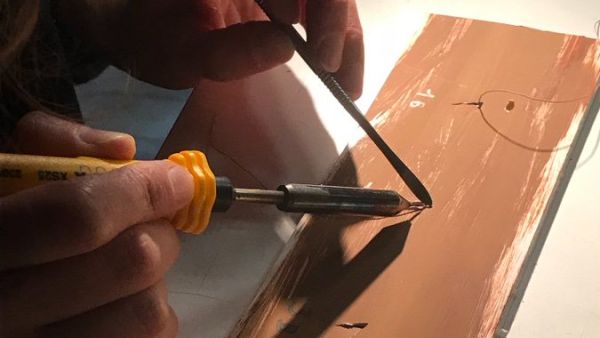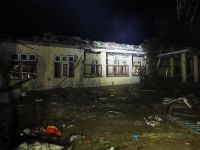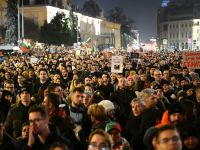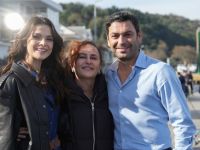When looking into Lebanese art history and the key players from the fabled Golden Age that impacted today’s art scene, Helen Khal’s name is unlikely to come up.
The Sursock Museum’s latest show, “At the Still Point of The Turning World, There Is the Dance,” seeks to spotlight this little-remembered artist, writer and critic, who was at the center of an artistic generation in the ’60s and ’70s, and unwittingly left a mark on many now considered great.
Curated by Carla Chammas and Rachel Dedman, the show is staged within the framework of Ashkal Alwan’s Home Works 8.
“There are 10 artists in this exhibition, including Helen,” Chammas said during a guided tour. “The obvious connections are that Helen’s lover was Chafic Abboud and her best friend was Huguette Caland, they worked and lived together.
“Helen was a respected Arabist and used to visit Saloua Raouda Choucair once a week and Aref Rayess was her mentor and encouraged her to express her creativity,” she added. “Yusuf Khal started this poetry review called ‘Shi’ir’ and Etel Adnan was one of his great participants, so is also there, and Simone Fattal worked on and illustrated some of the poems.
“Dorothy Salhab-Kazemi was someone that Helen knew and respected and was a big surprise for both Rachel and myself, I’d never seen her work,” Chammas said. “Farid Haddad was one of her students and became a close friend when she later moved to the U.S. ... and had some very important archives of that period.”
Born in the U.S. in 1923, Khal moved to Lebanon in the ’40s, going on to become a prolific painter, the co-founder of Gallery One and an art critic for The Daily Star and Monday Morning. The show uses Khal’s life as the genesis for exploring the work of artists she was connected to in life and art. Rather than look at individual artists through retrospectives, Dedman said that the intimate relationships between artists was what drove the narrative.
Split into three sections, the show’s first chapter, “Love, Gender, Sex, Motherhood,” begins with Khal’s book “The Women Artist in Lebanon,” and her own experience with love, loss and motherhood.
“She researched a great number of women artists that were present and working in Lebanon at the time, looking at how they had to balance society’s expectations of being wives and mothers with the freedoms they were offered as artists,” Dedman said. “For her own experience of love, you can read letters she wrote and received around her own search for love.
“She met and married Yusuf Khal relatively young and they were together for about 15 years but their divorce was bitter and he took custody of their children,” she added. “She was denied access to them and her struggles of motherhood are looked at in this section and how other artists balanced these two sides of their creative practice and everyday lives. We have these amazing pieces of furniture Choucair made for her daughter, and some illustrations that Rayess made for his daughter, which is so different from the intense, politicized work we know him for.”
The other half of the section looks at the importance of the female body and eroticism for artists. Works by Abboud, Achkar and Khal, as the first generation of art students at ALBA (the Lebanese Academy of Fine Arts), display their output with the nude. The artistically fluid relationship between artists is also highlighted.
“Huguette and Helen shared studios and are artists you wouldn’t think of as making the same work or put them side by side, but we know from the archives that they ... worked on these works at exactly the same time,” Dedman said. “Adnan and Fattal have been partners for 50 years now, collaborating on works as well - kinship between artists, even of different ages and generations, begins to run through the exhibition.”
As a writer, Helen was important in forming a discourse around understanding the contemporary Middle Eastern art scene at that time.
The second section, “Poetry and Painting,” explores the connection between the era’s literary landscape and the development of visual art. Yusuf Khal’s founding of the poetry journal “Shi’ir” in 1957 paved the way for modern Arab poets and how artists interacted with the written word.
“Yusuf Khal is one of the most famous poets of Arabic modernism and was one of the first people to translate the work of Anglo-American modernist poets into Arabic and begin to explore the styles that had been made well-known in the West, of T.S. Elliot, Ezra Pound and Archibald MacLeish in Arabic,” Dedman said. “This idea of free verse and the kind of works commissioned by ‘Shi’ir,’ the poets they published and translated, started this literary movement.
“Helen designed the earliest covers and Gallery One, which [she and Yusuf] founded together in 1963, was just across the hall from the journal’s offices,” she added. “It’s interesting to look at how the ideas of free verse ... translate into the works by artists who were exploring abstraction in a more visual sense.”
Archival material and artworks show how Haddad began working on graphic illustration; Fattal set up her publishing house Post-Apollo Press and collaborated with Adnan; Khal created illustrations for cowboy-and-Indian-style novels.
“It was also the opportunity to be a bit critical of the period, and the idea that it was this melting pot of people, which it was, but they would congregate in certain privileged spaces,” Dedman said. “You can read Helen’s writing about the Pan Arab Artists’ Federation that was being built and these different organizations that were trying to transcend these spaces and find new modes of collaboration and solidarity, which seem particularly pertinent with what is happening now.”
The final third of the exhibition, “The Studio and The Galley,” contrasts the relationship between the public nature of the gallery and the privacy of the studio. Gallery One was among the earliest spaces in Beirut and became a hub for artistic exchange.
“For us to put [these 10 artists’ works] next to each other tells a story that might not otherwise be seen when history tends to pocket artists within a style that they end up becoming best-known for,” Dedman said. “In the privacy of the studio ... Helen’s relationship with Huguette and Chafic were very informative and with Chafic this relationship really comes through in the hundreds of letters they wrote to each other.
“The fact that they were rocks for each other over the years,” she added, “close friends, occasional lovers, despite the different places they were living, is not something usually made visible in art history but for us was really telling, as a lens for looking at their work and understanding them as people.”
Illustrating these connections is material and documentation of a 40-painting joint show between Khal and Caland, who worked together at Caland’s Kaslik studio, sharing the same palette. Though most of these works were destroyed in a fire, the pair’s collaboration is evident in their keepsakes and letters.
“The only work not coming from this period is a diptych by Huguette called ‘Helen One and Two,’ made just after Helen’s death, which really affected her, so it was a poetic and fitting way about how she affected lives to end the show on,” Dedman said of the show’s final items. “In quiet and not necessarily visible ways, Helen made a huge impact.
“As a woman she was supercharismatic, a committed smoker and someone who is remembered by her fans and friends with special warmth,” she added, “even if she hasn’t necessarily been remembered by history.”
‘At the Still Point of The Turning World, There Is the Dance’ is showing at the Sursock Museum, Ashrafieh, until Jan. 19, 2020.
This article has been adapted from its original source.








